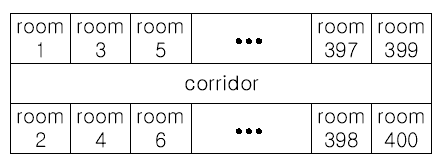HDOJ Moving Tables JAVA 1050
来源:互联网 发布:软件推广联盟 编辑:程序博客网 时间:2024/05/29 17:50
贪心算法
对于这个题,一开始走的是模拟的思想,建立了相应的类进行模拟,不仅慢,复杂,而且结果wrong(不知道为什么)
后来改进了思想才轻松AC的:
主要是看每个房间出现过几次。因为一个房间每次只能出现一次,所以出现的最多的次数就是答案。
package _1050;import java.util.Arrays;import java.util.Scanner;public class Main {public static void main(String[] args) {Scanner sc = new Scanner(System.in);int t = sc.nextInt();while((t--)!=0){int n = sc.nextInt();int[] cout = new int[401];while((n--)!=0){int s = sc.nextInt();int e = sc.nextInt();int l = Math.min(s, e);int r = Math.max(s, e);if(l%2==0)l--;if(r%2==1)r++;for (int i = l; i <= r; i++) {cout[i] += 10;}}//Arrays.sort(cout,Collections.reverseOrder());Arrays.sort(cout);System.out.println(cout[cout.length-1]);}}}老的解法:————————————————————
/** * *//** * @author Administrator可以改进:接收a,b时就将a,b处理,使得只在一边。 * */package _1050;import java.util.LinkedList;import java.util.List;import java.util.Scanner;class Case{int f,t;boolean hasGo;Case(int a,int b){f=a;t=b;hasGo = false;}}public class MainOldWrong{static List<Case> list ;public static void main(String[] args){Scanner sc = new Scanner(System.in);int t = sc.nextInt();while((t--)!=0){int n = sc.nextInt();list = new LinkedList<Case>();for (int i = 0; i < n; i++) {int a = sc.nextInt();int b = sc.nextInt();list.add(new Case(Math.min(a, b),Math.max(a, b)));}int ans = 0;for (int i = 0; i < list.size(); i++) {if(list.get(i).hasGo==false){list.get(i).hasGo = true;ans += 10;for (int j = 0; j < list.size(); j++) {if(i!=j&&!list.get(j).hasGo){if(canUnion(list.get(i),list.get(j))){list.get(j).hasGo = true;};}}}}System.out.println(ans);}}private static boolean canUnion(Case c1, Case c2) {if((c1.t<=c2.t&&c1.t>=c2.f) || (c2.t<=c1.t&&c2.t>=c1.f) ) return false;if(c1.t+1 == c2.f){if(c1.t%2==1) return false;}if(c2.t+1 == c1.f){if(c2.t%2==1) return false;}return true;}}Moving Tables
Time Limit: 2000/1000 MS (Java/Others) Memory Limit: 65536/32768 K (Java/Others)Total Submission(s): 38164 Accepted Submission(s): 12566
Problem Description
The famous ACM (Advanced Computer Maker) Company has rented a floor of a building whose shape is in the following figure.

The floor has 200 rooms each on the north side and south side along the corridor. Recently the Company made a plan to reform its system. The reform includes moving a lot of tables between rooms. Because the corridor is narrow and all the tables are big, only one table can pass through the corridor. Some plan is needed to make the moving efficient. The manager figured out the following plan: Moving a table from a room to another room can be done within 10 minutes. When moving a table from room i to room j, the part of the corridor between the front of room i and the front of room j is used. So, during each 10 minutes, several moving between two rooms not sharing the same part of the corridor will be done simultaneously. To make it clear the manager illustrated the possible cases and impossible cases of simultaneous moving.

For each room, at most one table will be either moved in or moved out. Now, the manager seeks out a method to minimize the time to move all the tables. Your job is to write a program to solve the manager’s problem.

The floor has 200 rooms each on the north side and south side along the corridor. Recently the Company made a plan to reform its system. The reform includes moving a lot of tables between rooms. Because the corridor is narrow and all the tables are big, only one table can pass through the corridor. Some plan is needed to make the moving efficient. The manager figured out the following plan: Moving a table from a room to another room can be done within 10 minutes. When moving a table from room i to room j, the part of the corridor between the front of room i and the front of room j is used. So, during each 10 minutes, several moving between two rooms not sharing the same part of the corridor will be done simultaneously. To make it clear the manager illustrated the possible cases and impossible cases of simultaneous moving.

For each room, at most one table will be either moved in or moved out. Now, the manager seeks out a method to minimize the time to move all the tables. Your job is to write a program to solve the manager’s problem.
Input
The input consists of T test cases. The number of test cases ) (T is given in the first line of the input. Each test case begins with a line containing an integer N , 1<=N<=200 , that represents the number of tables to move. Each of the following N lines contains two positive integers s and t, representing that a table is to move from room number s to room number t (each room number appears at most once in the N lines). From the N+3-rd line, the remaining test cases are listed in the same manner as above.
Output
The output should contain the minimum time in minutes to complete the moving, one per line.
Sample Input
3 4 10 20 30 40 50 60 70 80 2 1 3 2 200 3 10 100 20 80 30 50
Sample Output
102030
Source
Asia 2001, Taejon (South Korea)
阅读全文
0 0
- HDOJ Moving Tables JAVA 1050
- hdoj 1050 Moving Tables
- hdoj 1050 Moving Tables
- HDOJ 1050 Moving Tables
- HDOJ 1050 Moving Tables
- HDOJ 1050 Moving Tables
- HDOJ 1050 Moving Tables
- HDOJ 1050 Moving Tables
- HDOJ--1050Moving Tables!!
- hdoj.1050 Moving Tables 20140811
- HDOJ 1050 Moving Tables 【贪心】
- HDOJ 1050 Moving Tables (贪心)
- HDOJ HDU 1050 Moving Tables
- HDOJ 1050 Moving Tables解题报告
- HDOJ 1050:Moving Tables 解题报告
- HDOJ 1050 Moving Tables 贪心so easy!!
- HDOJ 1050 Moving Tables(贪心)
- HDOJ 1050 Moving Tables(经典贪心)
- canvas基础
- 视频播放器--jiecaovideoplayer
- SHA1算法与MD5算法的区别
- Greendao多线程下载
- MyApp
- HDOJ Moving Tables JAVA 1050
- 图像目标检测与跟踪学习笔记(二)
- opengl几何着色器实现爆破效果
- PAT考试乙级1036(C语言实现)
- 最小生成树--算法案列(poj1251)
- SourceTree如何创建新的项目
- NOIP2017提高成绩
- 神经网络基础—浅层神经网络
- jquery中$each()方法的使用指南


